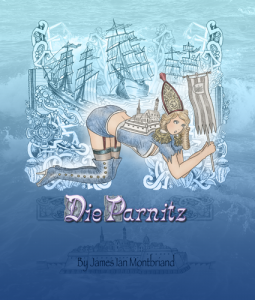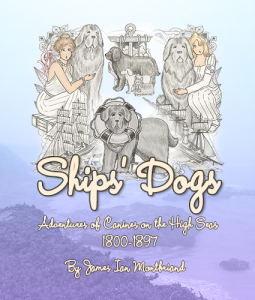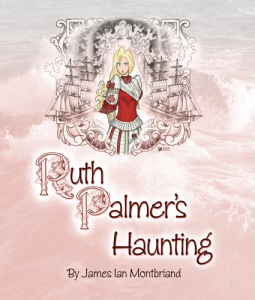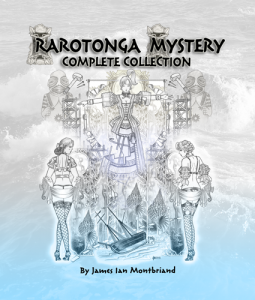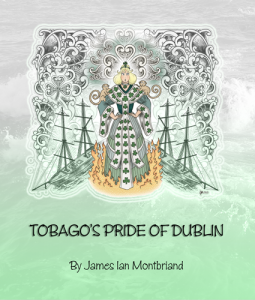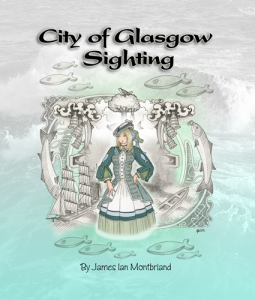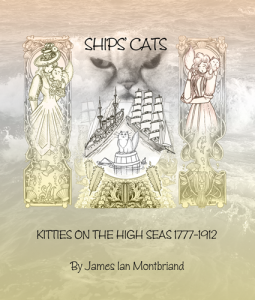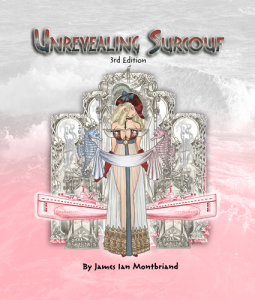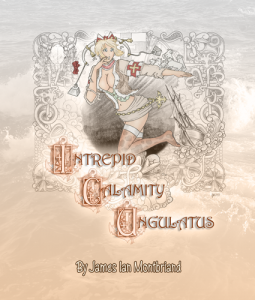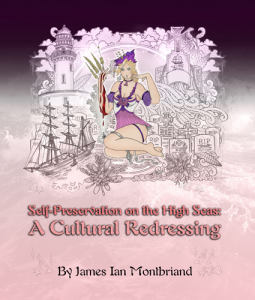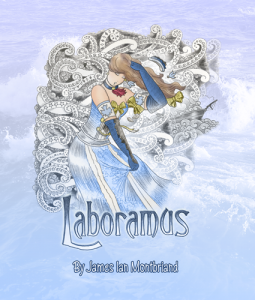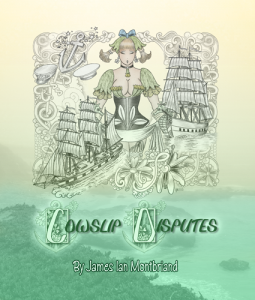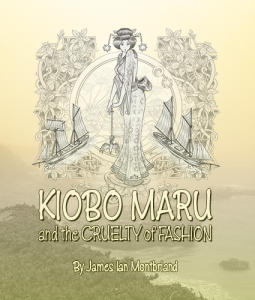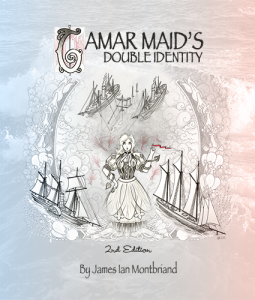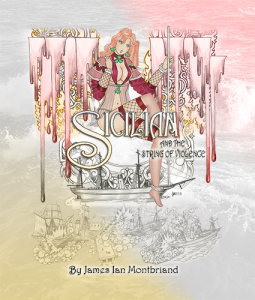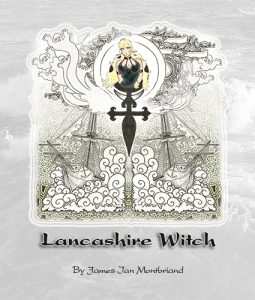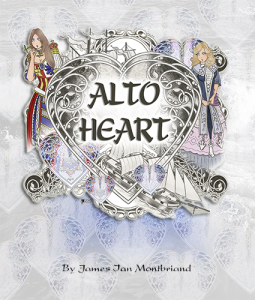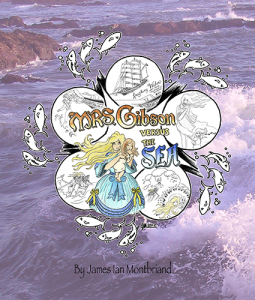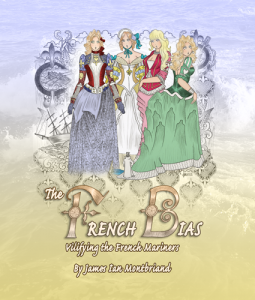Books about the sea
The following are illustrated short stories where the wind, the sea and the ship itself have a life of their own.
Prussian Derelict
The following illustrated short story is based on the actual reported events of the brig named the Die Parnitz (1851-1854) in 19th century newspapers. Originally this story was part of the book about the ship Frowning Beauty, but I considered it interesting enough to warrant making a separate book, just about the Prussian brig Die Parnitz. Besides the story of Die Parnitz, I thought I would expand the book to discuss changing attitudes in the 19th century about the practice of shooting sea fowl. The hoodoo accident that occurred to the Die Parnitz’s captain involved the shooting of sea fowl, but this was not a unique incident. Sometimes when I stumble upon an unusual event onboard an old sailing ship I find a larger social issue. In this case the broader topic was the reckless shooting of seabirds and the growing realization that this sport was inhumane.
See the details...
Ships' Dogs
The basis of the following illustrated short stories are actual articles printed in 19th century newspapers. Ever since I wrote the book Ships’ Cats, people have been asking me to writing a book about dogs on the high seas. Over the years, I have stumbled upon a number of good maritime dog stories, so I thought I would bring them together for you as one collection to enjoy. Most of the stories involve Newfoundland dogs, but on rare occasion another dog breed was mentioned. The nine short stories in this book capture a variety of characteristics and exploits of the ships’ dogs, ranging from heroic efforts of the canine companions to their quirky habits that set them apart from other dogs.
See the details...
Ruth Palmer's Haunting
The basis of the following illustrated short story is true-life events of the ship named Ruth Palmer (1875-1894) built in Dorchester, New Brunswick, Canada. Honestly this book started out as a bit of idle conversation at ‘Sunday Dinner’. I surmised that I could find a ship story for almost any name. We knew the neighbors at the lake might have shipbuilding ancestors so I selected their last name to conduct a search for a possible ship. Sure enough, there was a ship called the Palmer, in fact there were several ships called Palmer. So, I researched each and then selected one to write-up a short illustrated history.
See the details...
Rarotonga Mystery
To be honest I never intended to write this book. The research started as an interesting endnote about wrecks that reappeared on a shore decades after their demise. The Rarotongan shipwreck had the additional point of interest that the ship was unknown to the islanders. As the Roman historian Tacticus wrote: “What is unknown is taken for marvelous…” Therefore, I decided to identify this mysterious Rarotongan wreck. I recalled when I visited the Cook Islands, years ago, that I was disappointed the Island didn’t have any old sailing vessel shipwrecks. However, when I started to dig through all the newspaper archives it became clear to me there were at least six substantial sized ships that went ashore at Rarotonga. The endnote I had started making had grown into pages of information and illustrations. Finally, I just decided to make it a book onto itself. It seemed an interesting enough mystery to warrant this dedicated work.
See the details...
Tobago's Pride of Dublin
An old Tobagonian shipwreck story from the 1860’s retold from the perspective of the ship’s spirit “the Duchess of Leinster. Follow the saga of the Duchess from her grand launch in Dublin to her tragic final on the shores of Tobago. One of the most spectacular shipwrecks that occurred on the island of Tobago.
See the details...
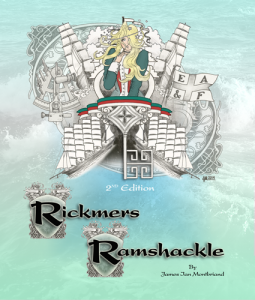
Rickmers Ramshackle
“Stay your course and hear my yarn” as Maria Rickmers would say. Find enclosed the tale of the disappearance of the monster sailing ship in 1892. Told in a ‘bastardized’ version of old sailor jargon that will leave you sails in luff. Better than bilge water and no worse than a scotch prize. Maria Rickmers tries to recap some of explanations of her disappearance on her maiden voyage, including the Nation in tow, the Azores Sighting, the Marzipan tin message, the Aikman yarn and the Philippine wreckage saga.
See the details...
City of Glasgow Sighting
Following illustrated short story is based on the true-life events of the steamship named the City of Glasgow (1850-54). The City of Glasgow disappeared without trace during a voyage across the North Atlantic Ocean in April 1854. Over 450 people vanished. The disappearance of the steamship has never been unravelled. There were a few disputed sightings of the City of Glasgow after her disappearance and the focus of this book is to investigate each of these occurrences.
See the details...
Kitties on the High Seas
Sometimes you might by chance notice cats gazing into a fish tank. They fool you by making you think they are fascinated by the fish, but what if there is something deeper to it than that. Maybe they are really regarding the ornamental shipwreck at the bottom of the tank. Perhaps they recall some of the names and deeds of their ancient kin. Famous ships’ cats - like Bo’sun, or Tom, or how about Unsinkable Sam or Blackie? They wax nostalgic over a time that has since passed. A time when kitties had exciting jobs on the high seas. A time when they could potentially be more than just any cat, but if they passed the rite of passage they could earn the title and prestigious
position of The Ship’s Cat.
See the details...
Unrevealing Surcouf
The following illustrated short story is based on the true-life disappearance
of the submarine named Surcouf (1929-1942). In the 2nd edition I have included some information about Surcouf Conspiracy (grigore), notes about the design anomaly of Surcouf and the Gold Medal Rescue of the Robert Surcouf in 1853. It should be noted that many of ship spirit representations have variations to their outfits from one depiction to the next. This is quite intention to try to bring to light the very one-off nature of the Surcouf submarine design.
See the details...
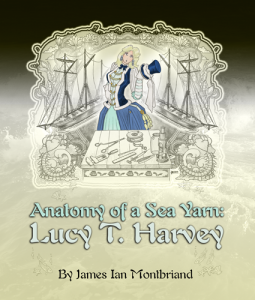
Anatomy of a Sea Yarn: Lucy T. Harvey
The basis of the following illustrated short story is an 1887 event reported in newspapers around the world. Whether the event really occurred or occurred as described I find questionable. I decided that it would be an excellent example of a potentially fabricated sea yarn. These ‘made-up’ stories became more common in the twilight decades of the sailing era. Although sea yarns did appear at earlier periods, they seemed to increase in number as sailors became armchair yarn spinners and commercial sailing (use of sailing ships to haul cargo) an activity of the past.
See the details...
Intrepid Calamity Ungulatus (ICU)
The basis of the following illustrated short story are actual events reported in 19th century newspapers. Since I did make a book about the Jersey Island privateers, I decided I better make a book featuring Guernsey Island. I don’t want to incur the wrath of the Channel Islanders. Before the use of refrigerated ships to bring meat to distant markets, mariners transported living animals across the ocean in ships. These voyages often incurred huge losses of life for the animals. Even in the best of weather these animals did not have good sea legs. From what I can tell, the Intrepid story is one of the worst Corunna Cattle Schooner disasters that occurred in the late 19th century. The schooner Intrepid was lost with all hands and hooves. To top it off, she was on her maiden voyage as a newly outfitted cattle schooner. So not just a stroke of bad luck, but double bad luck.
See the details...
Self Preservation on the High Seas
As for the subject of this book, cannibalism on the high seas is a grisly topic to discuss. All the same, I thought it was important to bring these old maritime stories to light. They need to be retold as a form of cultural redressing, a defense as it were, for the South Sea Islanders who’s ancestors have often been deplored by others for their practices of cannibalism. As the Europeans were busy condemning these ‘backward’ cultures, they needed to look inward and realize that in desperate situations their own people committed the very same act they were deploring in others.
See the details...
Laboramus
This story has a nice Canadian twist as the Laboramus is a Nova Scotian built vessel and one that bears testimony to the sturdy quality that Nova Scotians constructed in their ships. Laboramus’ derelict finale is one that should make all Nova Scotians proud. Interestingly enough Eliza Craven Green wrote a poem entitled Laboramus the year Nova Scotians launched the ship. By some strange irony much of the poems theme finds resonance in the saga of the Laboramus ship.
See the details...
Cowslip Disputes
The incidents of a captain’s alleged cruelty onboard the barque Cowslip are samples of a much larger phenomenon taking place on 19th century tall-masted sailing vessels. On the high seas, far from civilization, a ship’s captain was the solo decision-maker of justice. Sometimes his decisions and treatments of crew were unfair and tainted with personal dislike.
See the details...
Kiobo Maru
Anyone with a questioning mind about environmental issues will find this book an eye opener. Scanning past century's taste in fashionable hats, with arrays of gorgeous feathers will suddenly strike revulsion in the viewer's mind. Thousands, millions of birds were torn apart and left to die for the sake of fashion. Their feathers were ripped from their living bodies. Such are the horrors created by man. The stories in this book are a grim reminder to all of us who value the creatures of our world. A must read for everyone, not only the environmentalist.
See the details...
Tamar Maid
Do ships really come back from the sea to sail again? The is yes, but under certain circumstances. The Tamar Maid book contains three illustrated short stories about ships that have come back from the sea. These stories include: the Faroe Fetched Tale of 1893-94 (sensational, but highly unlikely event), the Posthumous Tale from 1834 and finally the Tamar Maid saga from the 1860s.
See the details...
Sicilian of Belfast
Could one ship really have so much bad luck and bad karma? Look no further than the Sicilian of Belfast. This naughty steamship always seemed to be running amuck of trouble. She was one of the ocean's collision queens, crashing into other ships, weirs and even the gates of hell (so to speak). It didn't end with just collisions, there were these strange incidents of violence always happening to her crew. Its not very often that iron rods drop from sky and impale people into the deck, but things like this happened on the Sicilian of Belfast.
See the details...
Lancashire Witch
The remarkable story of one of early sailing ships to have a Witch name, relive the memorable 1782 finale of the Lancashire Witch with nautical and lanky phrases mixed into the yarn.
See the details...
Alto Heart
The true-life events of the sailing ships Jacinta (Spanish Brig) and Alto (American Barque Whaling Ship) are the basis of the following illustrated short story. Rather than telling this story in the third person I decided the story would be more appropriate to narrate in the first person from the perspective of the ship's spirit (Jacinta). Let me take you back to 1857. Relive the heroic tale of Jacinta saving love on the high seas. Enjoy the saga of the "Alto Heart".
See the details...
Mrs. Gibson versus the Sea
Originally this story was a set of cartoons. The series span over nine cartoons and I was having difficulty finding a place to schedule all of them for my cartoon website. I decided to try my hand at e-publishing instead of posting them. The story I found in the newspapers about the finale of the barque Laughing Water was exceptional. At the highlight of the disastrous sinking, Mrs. Gibson appears on deck in her skimpy nightie holding her child in her arms. She was afraid, but determined, the sea would not take her child from her. Like a material representation of the ship’s spirit she became a rally point during the shipwreck.
See the details...
The French Bias
This book is a literary example of what could be best described as one of my research projects having a ‘ruptured appendix’. What started out as a reference in the appendix of one book developed into a separate book rather than a mere appendix. The research and stories grew in size until it simply was unwieldy as a postscript section. Often this persistent search for information is connected with my desire to find humor. Looking for something humorous in a subject matter sometimes adds a valuable sense of randomness to my research endeavours. I wander off the main path of any conventional lines of research simply to find something funny for a cartoon about the subject. On occasion, I open a regular Pandora’s box of untapped or overlooked information.
See the details...
